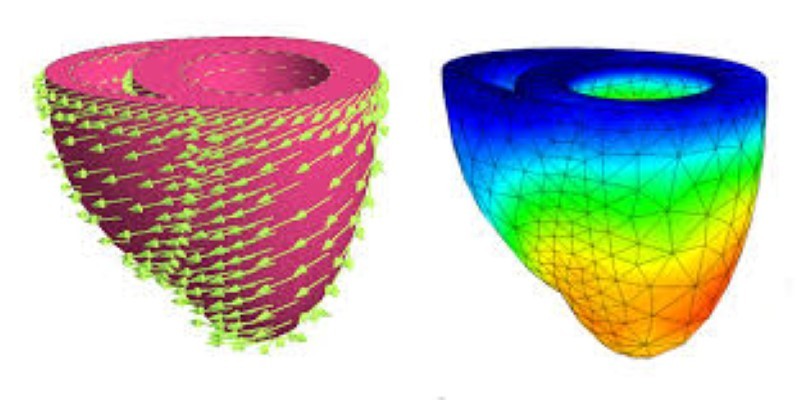
About Course
Computational Continuum Mechanics
Computational Continuum Mechanics as a full-fledged course is a very interesting but challenging subject. Usually, its application within the nonlinear finite element codes is not clear to the student. Computational continuum mechanics tries to bridge this gap.
Hence, it can be treated as an applied version of the continuum mechanics course. It assumes no prior exposure to continuum mechanics. The course starts with a sufficient introduction to tensors, kinematics, and kinetics. Then, the course applies these concepts to set up the constitutive relations for nonlinear finite element analysis of simple hyperelastic material.
This is followed by the linearization of the weak form of the equilibrium equations followed by discretization to obtain the finite element equations, in particular, the tangent matrices and residual vectors are discussed. Finally, the Newton-Raphson solution procedure is discussed along with line search and arc length methods to enhance the solution procedure.
INTENDED AUDIENCE: Masters student and research scholars
Course Content
Computational Continuum Mechanics
-
Lec 40: FE Formulation of Ductile Fracture in Dynamic Elasto-Plastic Contact Problem – Results
00:00 -
Lec 29: Isotropic Hyperelasticity, Neo-Hookean Material Model, Solved Examples
00:00 -
Lec 28: Isotropic hyperelasticity – material and spatial description, Hyperelastic models
00:00 -
Lec 27: Spatial Elasticity Tensor, Solved Example
00:00 -
Lec 26: Constitutive relations and constraints, Hyperelasticity, Material elasticity tensor
00:00 -
Lec 25: Solved Examples
00:00 -
Lec 24: Decomposition of Stress – 2, Objective Stress Measures
00:00 -
Lec 23: Second Piola-Kirchhoff Stress Tensor, Decomposition of Stress – 1
00:00 -
Lec 22: Work Conjugacy, First Piola-Kirchhoff Stress Tensor
00:00 -
Lec 30: Introduction, Linearization Process Overview
00:00 -
Lec 31: Linearization of Internal Virtual Work and External Virtual Work
00:00 -
Lec 39: FE Formulation of Ductile Fracture in Dynamic Elasto-Plastic Contact Problem – FEM
00:00 -
Lec 38: FE Formulation of Ductile Fracture in Dynamic Elasto-Plastic Contact Problem – Formulation
00:00 -
Lec 37: FE Formulation of Ductile Fracture in Dynamic Elasto-Plastic Contact Problem – Introduction
00:00 -
Lec 36: Arc Length Method, Solved Examples
00:00 -
Lec 35: Line Search Method
00:00 -
Lec 34: Newton Raphson Method
00:00 -
Lec 33: Discretization of Linearized Equilibrium Equations
00:00 -
Lec 32: Discretization of Kinematic Quantities, Equilibrium Equations
00:00 -
Lec 21: Equilibrium Equations – 2, Principle of Virtual Work
00:00 -
Lec 20: Objectivity, Stress Objectivity, Equilibrium Equations – 1
00:00 -
Lec 19: Cauchy’s Stress Principle – 2, Cauchy Stress Tensor
00:00 -
Lec 8: Linearization and directional derivative, Tensor analysis – 2
00:00 -
Lec 7: Linearization and directional derivative, Tensor analysis – 1
00:00 -
Lec 6: Tensor and Tensor Algebra – 4
00:00 -
Lec 5: Tensor and Tensor Algebra – 3
00:00 -
Lec 4: Tensor and Tensor Algebra – 2
00:00 -
Lec 3: Tensor and Tensor Algebra – 1
00:00 -
Lec 2: Origin of nonlinearities – 2
00:00 -
Lec 1: Origin of nonlinearities – 1
00:00 -
Lec 9: Worked Examples – 1
00:00 -
Lec 10: Worked Examples – 2
00:00 -
Lec 18: Conservation of Mass, Balance of Linear Momentum, Cauchy’s Stress Lec 18: Principle – 1
00:00 -
Lec 17: Solved Examples
00:00 -
Lec 16:Velocity Gradient, Rate of Deformation tensor, Area & Volume Rate, Reynolds Transport Theorem
00:00 -
Lec 15: Velocity, Acceleration, Material Time Derivative
00:00 -
Lec 14: Worked Examples, Linearized Kinematics
00:00 -
Lec 13: Polar Decomposition – 2, Volume and Area Change
00:00 -
Lec 12: Strain, Polar Decomposition – 1
00:00 -
Lec 11: Idea of Motion, Material and Spatial Descriptions, Deformation Gradient Tensor
00:00 -
Computational Continuum Mechanics [Intro Video]
00:00
Student Ratings & Reviews

